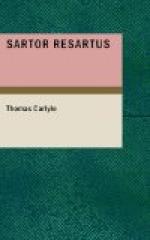“Of Symbols, however, I remark farther, that they have both an extrinsic and intrinsic value; oftenest the former only. What, for instance, was in that clouted Shoe, which the Peasants bore aloft with them as ensign in their Bauernkrieg (Peasants’ War)? Or in the Wallet-and-staff round which the Netherland Gueux, glorying in that nickname of Beggars, heroically rallied and prevailed, though against King Philip himself? Intrinsic significance these had none: only extrinsic; as the accidental Standards of multitudes more or less sacredly uniting together; in which union itself, as above noted, there is ever something mystical and borrowing of the Godlike. Under a like category, too, stand, or stood, the stupidest heraldic Coats-of-arms; military Banners everywhere; and generally all national or other sectarian Costumes and Customs: they have no intrinsic, necessary divineness, or even worth; but have acquired an extrinsic one. Nevertheless through all these there glimmers something of a Divine Idea; as through military Banners themselves, the Divine Idea of Duty, of heroic Daring; in some instances of Freedom, of Right. Nay the highest ensign that men ever met and embraced under, the Cross itself, had no meaning save an accidental extrinsic one.
“Another matter it is, however, when your Symbol has intrinsic meaning, and is of itself fit that men should unite round it. Let but the Godlike manifest itself to Sense, let but Eternity look, more or less visibly, through the Time-Figure (Zeitbild)! Then is it fit that men unite there; and worship together before such Symbol; and so from day to day, and from age to age, superadd to it new divineness.
“Of this latter sort are all true Works of Art: in them (if thou know a Work of Art from a Daub of Artifice) wilt thou discern Eternity looking through Time; the Godlike rendered visible. Here too may an extrinsic value gradually superadd itself: thus certain Iliads, and the like, have, in three thousand years, attained quite new significance. But nobler than all in this kind are the Lives of heroic god-inspired Men; for what other Work of Art is so divine? In Death too, in the Death of the Just, as the last perfection of a Work of Art, may we not discern symbolic meaning? In that divinely transfigured Sleep, as of Victory, resting over the beloved face which now knows thee no more, read (if thou canst for tears) the confluence of Time with Eternity, and some gleam of the latter peering through.
“Highest of all Symbols are those wherein the Artist or Poet has risen into Prophet, and all men can recognize a present God, and worship the Same: I mean religious Symbols. Various enough have been such religious Symbols, what we call Religions; as men stood in this stage of culture or the other, and could worse or better body forth the Godlike: some Symbols with a transient intrinsic worth; many with only an extrinsic. If thou ask to what height man has carried it in this manner, look on our divinest Symbol: on Jesus of Nazareth, and his Life, and his Biography, and what followed therefrom. Higher has the human Thought not yet reached: this is Christianity and Christendom; a Symbol of quite perennial, infinite character; whose significance will ever demand to be anew inquired into, and anew made manifest.




